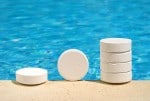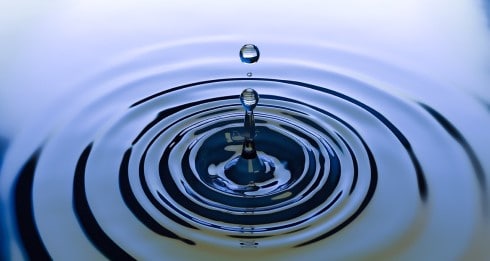If you have read our posts on general pool water chemistry or chlorine, you’ve likely seen the term, cyanuric acid, stabilizer, or conditioner. All 3 terms are used relatively interchangeably. The pros, and occasionally adverts will refer to it shorthanded as CYA. So, if you’ve ever had a salesperson tell you; “sir/ma’am, you need to use dichlor, or trichlor instead of liquid chlorine because it’s stabilized”, this is what they were talking about. For the purposes of our discussion, I will refer to it as its chemical name, Cyanuric Acid.
I won’t go into painstaking detail on this post, but I will cover the high points on what you need to know as a consumer about Cyanuric acid and adding it to your pool. If you want to get into the chemical compounds and properties, the Wikipedia page is pretty extensive and accurate as compared to our industry workbooks.
We’ll talk about.
- What is cyanuric acid
- Why you need to add it, or why you may not want to
- Is it safe to swim in water with Cyanuric Acid in it?
What is Cyanuric Acid

Cyanuric acid from a chemical standpoint is sun protection for chlorine. At its most basic, its sole purpose is to keep chlorine from degrading from sun exposure, or really UV exposure. Cyanuric acid stabilizes chlorine from sunlight exposure. (you see what I did there?) How cyanuric acid works is a bit on the scientific side. I’m no scientist, but a simplified view is that cyanuric acid will attach itself to a chlorine molecule to act as a barrier, given that other parameters are met, which we won’t get into.
To use a sports analogy from American Football; If chlorine were a ball carrier and the endzone was the algae or other foreign pool contaminant, then sunlight would be the defenders trying to get the football, preventing it from getting to the endzone. Introduce cyanuric acid, the blockers. A blocker’s job is to keep defenders away from the ball carrier long enough to achieve his goal of getting to the endzone.
Cyanuric acid is simply that, it protects chlorine in the swimming pool from being removed, or burning out, by sunlight. In a perfect application, it stabilizes the chlorine long enough that it can kill whatever contaminants it needs to, is used up and then the cyanuric acid moves along to the next available chlorine molecule.
Why Add Cyanuric Acid to Pool Water
So, the why should be obvious here. Add cyanuric acid to a swimming pool in order to keep chlorine in the pool. Then the chlorine can do what the chlorine is there to do; sanitize and oxidize. Studies have shown that a swimming pool where conditioner is not present can lose its entire chlorine residual within an hour and a half of being added. That’s not even long enough for the chlorine to circulate through the whole pool! Quite literally, pouring money down the drain.
If you are using chlorine source that is not stable, such as liquid chlorine (sodium chloride) or a salt chlorine generator (SCG), using cyanuric acid in your pool is a virtual must. Unless of course you want to show off to all your friends how much money you spend on chlorine, in which case, more power to you!
The variables as to when you may not need cyanuric acid are just a few. If you have an indoor pool that is fairly protected from the sun, like little or no windows to the outside, you probably won’t need stabilizer in your pool. Hey, if the defense isn’t on the field you don’t need blockers right!? You know what I mean 1987 Dolphins fans. (sorry I saw my shot…)
Also, if you aren’t using chlorine you won’t need or use CYA. Cyanuric acid only works on protecting chlorine is swimming pools. If your pool uses ozone, bromine, or enzymes to act as a chlorine replacement, stabilizer will do nothing for you. IF however, you still keep a low chlorine residual (.5 – 1ppm) to augment an ozone or enzyme system, then cyanuric acid in your swimming pool still makes sense, just keep it at a lower ppm.
How Much Cyanuric Acid Should be Added to Swimming Pool Water?
As with any chemical that is added to swimming pool water, care should always be taken. Test the water first for the chemical being added. There are plenty of Cyanuric Acid level tests available to consumers and pros alike. I like this one from Taylor on Amazon, in fact, it’s the exact kit that most field techs use and its as accurate as you can get without having the high-end electronic testers.
Keep in mind that the proper range will vary, but a good rule to go by is 10x your desired chlorine level. So if you keep your chlorine at 3.0 ppm, you would keep your CYA at about 30 ppm. Since cyanuric acid does not evaporate from swimming pools, you will only need to add it every couple of years.

A word of caution if using trichlor or dichlor tabs. These contain stabilizer and will add to your levels in the pool. It’s not uncommon for pools that use these as a primary source of chlorination to reach upwards of 100 ppm of cyanuric acid.
Is Cyanuric Acid Safe to add to pool water?
The key here is to have the right amount of cyanuric acid in the water. Going back to our football analogy. What if hypothetically there were so many blockers surrounding the ball carrier that there was 100% protection from defenders, but he couldn’t move. The blockers would have done their job, but the ball carrier couldn’t do his, namely getting to the endzone?
The point here is that the CYA count can get too high for the chlorine to do its job. Historically 100ppm is the maximum, more recent studies are starting to show recommendations of less than 30ppm. My personal experience in servicing pools for over 12 years has told me that 20 – 40 ppm of cyanuric acid in a swimming pool is about right. This will protect the chlorine, and still allow the chlorine to act as an oxidizer and sanitizer without “trapping” it. So as far as your pool is concerned, yes it is safe to add cyanuric acid to swimming pool water.
Is Cyanuric Acid Safe to Swim in?

This would be the follow-up question to the previous one… Back in 1984, there were allegations that CYA caused cancer. Follow-up testing has shown cyanuric acid to be well within the levels of toxicity and is not a carcinogen, mutagen, etc. It does not penetrate the skin at a significant rate and the ingestion rate that would exist at “normal” levels in any pool would be well below any benchmark of toxicity even for a small child. Again, check out the Wikipedia page, it’s pretty thorough.
To summarize this question; yes, it is safe to swim in a pool with cyanuric acid in it. Even if the levels were sky high, cyanuric acid would pose no real threat to human health.
Check out the next article to see where pool algae come from and how to manage it.
Are you stuck on how and when to maintain your swimming pool filter? Check out this article on just exactly that!
Do you have a specific concern or question about pool maintenance? Leave a comment below, and we’ll try to get to it in a future article.
If you like our comment, join our email list to get notified when we post and get our newsletter.
Recent Posts
The Origin of Green Algae in Swimming Pools: Unveiling the Culprit
Swimming pools are synonymous with relaxation, fun, and refreshing dips during hot summer days. However, the appearance of green algae can turn this enjoyable experience into a frustrating one. Green...
At the heart of every pool is a filter pump that needs to be run every day for a specified length of time. Rather than try to remember to turn a pool pump on and off every day, pool builders and...


